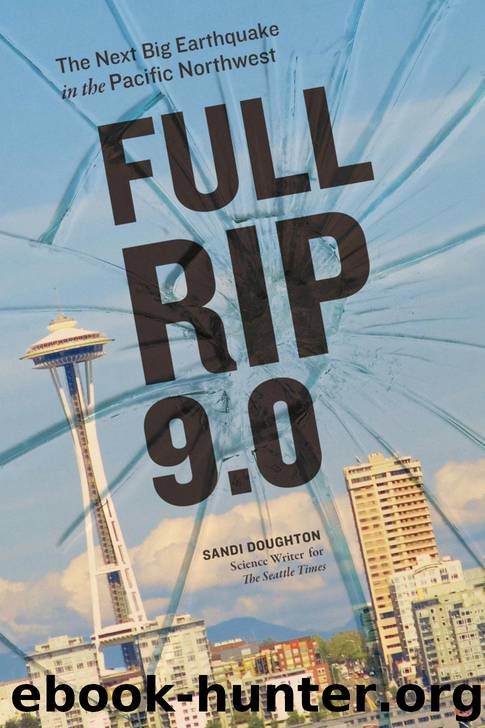Full-Rip 9.0: The Next Big Earthquake in the Pacific Northwest by Sandi Doughton

Author:Sandi Doughton [Doughton, Sandi]
Language: eng
Format: epub
Tags: Non-Fiction
ISBN: 9781570618550
Google: VSj-0CHXPX0C
Amazon: B00A5MRCJU
Publisher: Sasquatch Books
Published: 2013-06-11T07:00:00+00:00
Nisqually was Carol Davis’s most serene seismic experience. From the chairlift at Crystal Mountain ski area, she noticed something odd about the treetops. “They were dancing, waving back and forth,” she recalled. The chair stopped for about ten minutes. “I said to my friend, ‘I’ll bet that was an earthquake.’ ” At the top of the hill, a message board confirmed Davis’s hunch. The road down the mountain was blocked for hours by boulders and fallen trees. Back at home Davis’s broken bric-a-brac were the only casualties.
USGS seismologist Bob Norris’s day got off to a more explosive start. He was bumping along a gravel road on Seattle’s Harbor Island, a sprawling industrial complex that sits on what used to be the Duwamish River Delta. Fill shakes harder than any other type of ground, so the USGS had installed a strong-motion seismometer near a tank farm in the former tide flat. Norris was there to download data from the instrument.
When the earthquake hit, he thought he had run over something. Norris stopped the truck. “I went through several seconds of confusion because the truck was still rocking sharply,” he recalled. In most parts of town, the strongest motion lasted about twenty seconds. But the ground under Norris’s truck kept pounding like a jackhammer. All he could do was hold on and hope his head didn’t smash into the windshield. As the motion eased, he watched two-hundred-foot cargo cranes flexing “like huge steel giraffes trying to dance.”
What happened next was something even the seasoned earthquake scientist had never seen. Almost ten minutes after the shaking stopped, water started pouring from the ground, then coalesced into a muddy geyser. Norris at first thought the quake had broken a water pipe. But what he was witnessing was liquefaction. When sandy soils take a seismic pounding, they turn to a watery slop. Some of that water is ejected from the ground under pressure. By the time Norris left, the swirling pool was fifty feet across and growing by the second.
Liquefaction in built-up tide flats, waterfronts, and along river valleys is a serious cause of damage in major quakes, undermining structures and heaving up buried utility lines. In the days and weeks that followed the Nisqually quake, scientists fanned out across the region to catalog liquefaction effects. They found sinkholes, buildings with lopsided foundations, and cracks in airport runways.
Scientifically, the quake was a bonanza. One group of researchers examined stream gauges and discovered that water levels spiked in many areas, presumably because the quake compacted the soil and squeezed out groundwater. Another team followed the trail of broken chimneys to identify neighborhoods that shook harder than others. Spectacular sand volcanoes, like the one Norris saw, erupted around Lake Sammamish east of Seattle, as buried sand liquified by the shaking burst to the surface like toothpaste shot from a tube. Worms surfaced, too—as many as one per square foot in the most jostled areas. Every evening scientists and building engineers gathered at the University of Washington to drink beer and talk about what they’d seen.
Download
This site does not store any files on its server. We only index and link to content provided by other sites. Please contact the content providers to delete copyright contents if any and email us, we'll remove relevant links or contents immediately.
Man-made Catastrophes and Risk Information Concealment by Dmitry Chernov & Didier Sornette(4734)
The Revenge of Geography: What the Map Tells Us About Coming Conflicts and the Battle Against Fate by Kaplan Robert D(3597)
Zero Waste Home by Bea Johnson(3288)
COSMOS by Carl Sagan(2949)
In a Sunburned Country by Bill Bryson(2945)
Good by S. Walden(2912)
The Fate of Rome: Climate, Disease, and the End of an Empire (The Princeton History of the Ancient World) by Kyle Harper(2434)
Camino Island by John Grisham(2382)
A Wilder Time by William E. Glassley(2362)
Organic Mushroom Farming and Mycoremediation by Tradd Cotter(2305)
Human Dynamics Research in Smart and Connected Communities by Shih-Lung Shaw & Daniel Sui(2176)
The Ogre by Doug Scott(2113)
Energy Myths and Realities by Vaclav Smil(2059)
The Traveler's Gift by Andy Andrews(2009)
Inside the Middle East by Avi Melamed(1938)
Birds of New Guinea by Pratt Thane K.; Beehler Bruce M.; Anderton John C(1906)
Ultimate Navigation Manual by Lyle Brotherton(1767)
A History of Warfare by John Keegan(1712)
And the Band Played On by Randy Shilts(1615)
